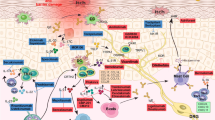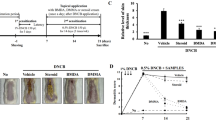Abstract
Atopic dermatitis, a chronic inflammatory skin disease characterized by relapsing eczema and intense prurigo, requires effective and safe pharmacological therapy. In this study, we examined the efficacy of ointment containing NF-kB decoy oligodeoxynucleotides (ODN) on atopic dermatitis lesions in NC/Nga mice, which are characterized by the spontaneous onset of atopic dermatitis in conventional conditions. Topical administration of NF-kB decoy ODN twice a month resulted in a significant reduction in clinical skin condition score and marked improvement of histological findings. Reduction of the atopic skin condition by NF-kB decoy ODN was accompanied by a significant decrease in migration of mast cells into the dermis and an increase in apoptotic cells. Here, we demonstrated the successful treatment of atopic dermatitis with ointment containing NF-kB decoy ODN in a mouse model, promising new therapy for atopic dermatitis.
This is a preview of subscription content, access via your institution
Access options
Subscribe to this journal
Receive 12 print issues and online access
$259.00 per year
only $21.58 per issue
Buy this article
- Purchase on Springer Link
- Instant access to full article PDF
Prices may be subject to local taxes which are calculated during checkout












Similar content being viewed by others

References
Pastore S et al. Pathogenetic mechanisms of atopic dermatitis Arch Immunol Ther Exp (Warsz) 2000 48: 497–504
Leung DYM . Atopic dermatitis: new insights and opportunities for therapeutic intervention J Allergy Clin Immunol 2000 105: 860–876
Romangnani S . The role of lymphocytes in allergic disease J Allergy Clin Immunol 2000 105: 399–408
Akdis CA, Akdis M, Trautmann A, Blaser K . Immune regulation in atopic dermatitis Curr Opin Immunol 2000 12: 641–646
Wollenberg A, Bieber T . Atopic dermatitis: from the genes to skin lesions Allergy 2000 55: 205–213
Leung DYM . Atopic dermatitis: immunobiology and treatment with immune modulators Clin Exp Immunol 1997 107: 25–30
Makarov SS . NFkB as a therapeutic target in chronic inflammation: recent advances Mol Med Today 2000 6: 441–448
Paul HL . Activators and target genes of Rel/NF-kB transcription factors Oncogene 1999 18: 6853–6866
Morishita R, Higaki J, Tomita N, Ogihara T . Application of transcription factor ‘decoy’ strategy as means of gene therapy and study of gene expression in cardiovascular disease Circ Res 1990 82: 1023–1028
Morishita R, Aoki M, Kaneda Y . Oligonucleotides-based gene therapy for cardiovascular disease: are oligonucleotides therapeutics novel cardiovascular drugs? Current Drug Targets 2000 1: 15–23
Morishita R et al. In vivo transfection of cis element ‘decoy’ against nuclear factor-kB binding site prevents myocardial infarction Nat Med 1997 3: 894–899
Tomita T et al. Suppressed severity of collagen-induced arthritis by in vivo transfection of nuclear factor kB decoy oligodeoxynucleotides as a gene therapy Arthritis Rheum 1999 42: 2532–2542
Kawamura I et al. Intratumoral injection of oligonucleotides to the NF-kappaB binding site inhibits cachexia in a mouse tumor model Gene Therapy 1999 6: 91–97
Tomita N et al. In vivo administration of a nuclear factor-kB decoy suppresses experimental crescentic glomerulonephritis J Am Soc Nephrol 2000 11: 1244–1252
Kawamura I et al. Intravenous injection of oligonucleotides to the NF-kappaB binding site inhibits hepatic metastasis of M5076 reticulosarcoma in mice Gene Therapy 2001 8: 905–912
Matsuda H et al. Development of atopic dermatitis-like skin lesion with IgE hyperproduction in NC/Nga mice Int Immunol 1997 107: 461–466
Suto H et al. NC/Nga mice: a mouse model for atopic dermatitis Int Arch Allergy Immunol 1999 120: 70–75
Sugiura K et al. The study on the role of Myocoptes musculinus (kekuidani) on the skin eruptions of the atopic model mice (NC mice) Environ Dermatol 2000 7: 52–60
Mehta RC et al. Intercellular adhesion molecule-1 suppression in skin by topical delivery of anti-sense oligonucleotides J Invest Dermatol 2000 115: 805–812
Tomita N et al. Transcription factor decoy for nuclear factor-kB inhibits tumor necrosis factor-induced expression of interleukin-6 and intercellular adhesion molecule-1 in endothelial cells J Hypertens 1998 16: 993–1000
Yoshikawa H, Tasaka K . Suppression of mast cell activation by glucocorticoid Arch Immunol Ther Exp (Warsz) 2000 48: 487–495
Nakagawa H et al. Tacrolimus ointment for atopic dermatitis Lancet 1994 344: 883
Hiroi J et al. Effect of tacrolimus hydrate (FK506) ointment on spontaneous dermatitis in NC/Nga mice Jpn J Pharmacol 1998 76: 175–183
Trautman A, Akdis M, Blaser K, Akdis CA . Role of dysregulated apoptosis in atopic dermatitis Apoptosis 2000 5: 425–429
Klement JF et al. IkappaBalpha deficiency results in a sustained NF-kappaB response and severe widespread dermatitis in mice Mol Cell Biol 1996 16: 2341–2349
Barton D, HogenEsch H, Weih F . Mice lacking the transcription factor RelB develop T cell-dependent skin lesions similar to human atopic dermatitis Eur J Immunol 2000 30: 2323–2332
Xia Y et al. RelB modulation of IkappaBalpha stability as a mechanism of transcription suppression of interleukin-1alpha (IL-1alpha), IL-1beta, and tumor necrosis factor alpha in fibroblasts Mol Cell Biol 1999 19: 7688–7696
Roque F et al. Safety of intracoronary administration of c-myc antisense oligomers after percutaneous transluminal coronary angioplasty (PTCA) Antisense Nucleic Acid Drug Dev 2001 2: 99–106
Cunningham CC . A phase I trial of c-Raf kinase antisense oligonucleotide ISIS 5132 administered as a continuous intravenous infusion in patients with advanced cancer Clin Cancer Res 2000 6: 1626–1631
Neish AS et al. Functional analysis of the human vascular cell adhesion molecule 1 promoter J Exp Med 1992 176: 1583–1593
Kittelberger R, Davis PF, Stehbens WE . An improved immunofluorescence technique for the histological examination of blood vessel tissue Acta Histochem 1989 86: 137–142
Morishita R et al. Pharmacokinetics of antisense oligodeoxyribonucleotides (cyclin B1 and CDC 2 kinase) in the vessel wall in vivo: enhanced therapeutic utility for restenosis by HVJ-liposome delivery Gene 1994 149: 13–19
Gavrieli Y, Sherman Y, Ben-Sasson SA . Identification of programmed cell death in situ via specific labeling of nuclear DNA fragmentation J Cell Biol 1992 119: 493–501
Acknowledgements
We thank Mr T Ouchi (SRL) for histological examination, Mr Y Tatsumi (Nara Pathological Research Center) for immunohistochemical examination, Dr M Matsumoto and Dr M Kotani (SunStar) for helpful advice on the clinical skin condition score of atopic dermatitis. This work was partially supported by a grant from the Japan Health Sciences Foundation, a Grant-in-Aid from The Ministry of Public Health and Welfare, a Grant-in-Aid for the Development of Innovative Technology, a Grant-in-Aid from Japan Promotion of Science, and Special Coordination Funds of the Ministry of Education, Culture, Sports, Science and Technology, the Japanese Government.
Author information
Authors and Affiliations
Rights and permissions
About this article
Cite this article
Nakamura, H., Aoki, M., Tamai, K. et al. Prevention and regression of atopic dermatitis by ointment containing NF-kB decoy oligodeoxynucleotides in NC/Nga atopic mouse model. Gene Ther 9, 1221–1229 (2002). https://doi.org/10.1038/sj.gt.3301724
Received:
Accepted:
Published:
Issue Date:
DOI: https://doi.org/10.1038/sj.gt.3301724
Keywords
This article is cited by
-
Inhibitory Effects of Euscaphic Acid in the Atopic Dermatitis Model by Reducing Skin Inflammation and Intense Pruritus
Inflammation (2022)
-
Cancer immunotherapy using the Fusion gene of Sendai virus
Cancer Gene Therapy (2020)
-
A new approach to transfect NF-κB decoy oligodeoxynucleotides into the periodontal tissue using the ultrasound-microbubble method
International Journal of Oral Science (2017)
-
Loss of c-REL but not NF-κB2 prevents autoimmune disease driven by FasL mutation
Cell Death & Differentiation (2015)
-
Effect of extract from laquer tree (Rhus verniciflua Stokes) on DNCB-induced atopic dermatitis in NC/Nga mouse
Food Science and Biotechnology (2012)


